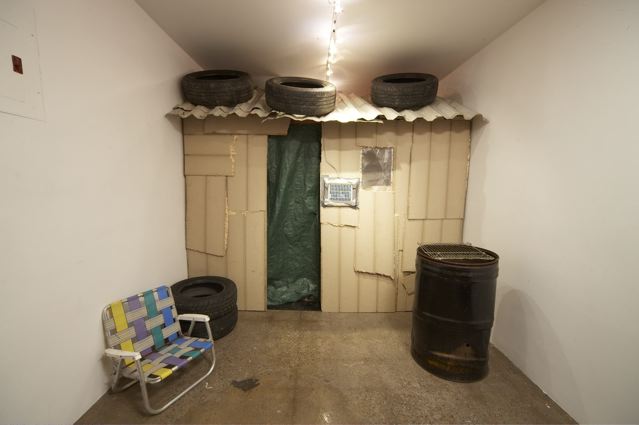This is an archive of the ArtCat Zine, 2007-2009. Please visit our new project, IDIOM.
Bienvenue à la maison des cartes. Can I interest you in a found object?

House of Cards
Lisa Kirk
Invisible Exports - 14A Orchard Street, New York NY
20 February - 29 March 2009
One of the most provocative pieces in Revolution, Lisa Kirk's self-described "fragrance lab and terrorist headquarters" exhibited last summer at P.S.1, was a commercial for a product dubbed "Revolution: the Fragrance." Shot in the style of an overaestheticized Nike ad, the short cut between stylized Manhattan street scenes and two sets of runners (joggers? Thieves?) sprinting down the sidewalks of the Lower East Side. At the commercial's end, a bomb explodes, and with no shortage of gravitas the camera pulls back to expose two black-clad figures slowing to meet each other. Masks come off, a detonator is revealed, and the logo: Revolution… the fragrance.
Lisa Kirk, in other words, is no stranger to exploring and mocking the perversities of late capitalist society. With Revolution, she dissected popular culture's urge to fetishize and commodify transgression, and now, with House of Cards, her latest show currently at Invisible-Exports, she examines a related theme: the tension between capitalism's values and its increasingly rapid decline.
House of Cards (or Maison des cartes, as the promotional material sneers) is, at first glance, a stark aestheticization of poverty. A shanty within a gallery, the viewer enters the space through walking into a tin shack with tires framing the roof and door. Once inside, the house is fully equipped with a kitchen (stacked tires and a metal bowl) a bed (scrap materials next to a 1964 encyclopedia) and a bathroom (a hole in the wall thoughtfully accompanied by a hanging roll of toilet paper). While ostensibly a critique of commercialism, with its ironic pragmatism and DIY feel, House of Cards departs from the frontal approach of Revolution and takes a slightly different tact. Appealing to freegans aesthetically and consumers directly -- "Invest in who YOU are and what YOU stand for" – the show implicates everyone within the market economy by suggesting first that capitalism is headed to the favelas, and second, that in hard times, the revolutionaries and the rich start to look awfully alike.
Advertised as a "shanty timeshare," the work itself is composed of 52 different pieces of found materials, and can actually be rented or purchased through one of three different payment options. Under the basic option (an all-time low of $199.99!) the timeshare owner is granted a deed and a week in the shanty, and under the silver and gold options, the owner buys a week, a deed, and a piece of the shanty itself. In order to avoid the confusion of running a timeshare out of the gallery space (although it seemed to work rather well at the Guggenheim) come early March, the shanty will take up residency in the Brooklyn Navy Yard. At the end of the year, the pieces will be disassembled and distributed to timeshare owners "as 52 separate and unique artworks." If you have any questions, you can consult the realtor. His office is directly behind the shanty.
As Kirk's press release points out, House of Cards is more than just a satire of consumerist society. It's also an invocation of one of the most powerful images in contemporary global politics. As Mike Davis famously argued in Planet of Slums, poverty is not only one of the most entrenched and overlooked social problems in the world, it's also one of the fastest growing, metastasizing at a rate that far outpaces those working against it. In House of Cards, Kirk calls upon this history, but in tying the image of the shanty to Western materialist values, she casts a darkly ironic light on one of Davis' central questions: "Are the great slums, as a terrified Victorian middle class once imagined, volcanoes waiting to erupt?"
Not anymore. They're waiting to be sold to the highest bidder. And if you're looking for revolution, it can be found downstairs, where parts of her P.S.1 show are on display.
ZINE
HOME
TIPS / COMMENTS
CATEGORIES
CONTRIBUTORS
- Greg Afinogenov
- B. Blagojevic
- Adda Birnir
- Susannah Edelbaum
- Julie Fishkin
- Paddy Johnson
- Jessica Loudis
- Christopher Reiger
- Andrew Robinson
- Peter J. Russo
- Blythe Sheldon
- S.C.Squibb
- Hrag Vartanian

